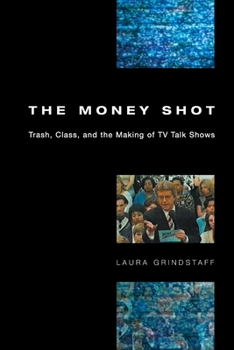The Money Shot: Trash, Class, and the Making of TV Talk Shows
Select Format
Select Condition 
Book Overview
He leaped from his chair, ripped off his microphone, and lunged at his ex-wife. Security guards rushed to intercept him. The audience screamed, then cheered. Were producers concerned? Not at all. They were getting what they wanted: the money shot. From "classy" shows like Oprah to "trashy" shows like Jerry Springer, the key to a talk show's success is what Laura Grindstaff calls the money shot--moments when guests lose control and express joy, sorrow, rage, or remorse on camera. In this new work, Grindstaff takes us behind the scenes of daytime television talk shows, a genre focused on "real" stories told by "ordinary" people. Drawing on extensive interviews with producers and guests, her own attendance of dozens of live tapings around the country, and more than a year's experience working on two nationally televised shows, Grindstaff shows us how producers elicit dramatic performances from guests, why guests agree to participate, and the supporting roles played by studio audiences and experts. Grindstaff traces the career of the money shot, examining how producers make stars and experts out of ordinary people, in the process reproducing old forms of cultural hierarchy and class inequality even while seeming to challenge them. She argues that the daytime talk show does give voice to people normally excluded from the media spotlight, but it lets them speak only in certain ways and under certain rules and conditions. Working to understand the genre from the inside rather than pass judgment on it from the outside, Grindstaff asks not just what talk shows can tell us about mass media, but also what they reveal about American culture more generally.
Format:Paperback
Language:English
ISBN:0226309118
ISBN13:9780226309118
Release Date:July 2002
Publisher:University of Chicago Press
Length:325 Pages
Weight:1.02 lbs.
Dimensions:0.7" x 6.1" x 9.0"
Customer Reviews
3 ratings
Read if you're curious what's real & what's fake
Published by Thriftbooks.com User , 19 years ago
I found this book very informative, and it answered my many questions about the truth behind talk shows. The author presents the industry from all angles, from studio audience to home audience to guests to producers. The only drawback is that I found some parts of the book overloaded with "big words" that are not necessary, and are distracting from the substance of the book. For example: "Such practices do not guarantee fireworks and drama, but they help because they locate the potential for dramatic interaction in the strategic juxtaposition of participants rather than (or in addition to) individual performative competence." I consider myself to be fairly skilled when it comes to vocabulary, but I found myself having to reread paragraphs on many occasions. If you're genuinely interested in the topic of talk shows, as I was, it will probably be worth your while to read. It will probably answer all of your questions, if you're willing to pluck the answers out from behind the excess wording.
Going Back Stage
Published by Thriftbooks.com User , 22 years ago
I am, unabashedly, a talk show junkie. At some level my interest is undeniably scatalogical. Still, as a sociologist, my real fascination is with the culture of such programming and its impact upon American culture. Grindstaff's ethnographic exploration of two American talk shows answers many of my questions about how such programs are produced (the mechanics), the people involved ('ordinary' guests, 'expert' guests, those working behind the scenes, and the hosts), and offers insight into why we are hooked on this type of spectacle. Her treatment of the subject and those involved is even handed and avoids the obvious pitfalls of stereotyping and villifying. For those interested in popular culture, American ethnography, issues of authenticity, and cultural studies, Grindstaff's text should find its way to your bookshelf ASAP.
Television Talk and Blow-by-Blow Commentary
Published by Thriftbooks.com User , 22 years ago
Grindstaff has produced an excellent book exposing the underbelly of daytime talk show production. Her profuse detail gathered through extensive ethnographic fieldwork pays off in an effective account explaining the production process associated with the talk show. We see how the offbeat topics are formulated, guests recruited, and production secured on numerous talk show episodes. We are taken behind the scenes and understand that it is a small miracle that the television format manages to survive on a daily basis. The writing is precise and the volume is well annotated.A fan of these talk shows will gain greater appreciation of how the process is structured and the impact upon producers, talk show guests, and studio audience members. This is a magnificent analysis that should be read by everyone curious about the talk show phenomenon.






